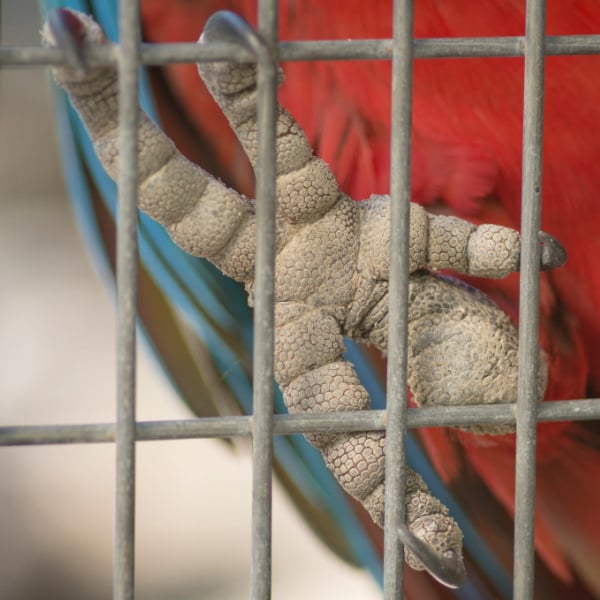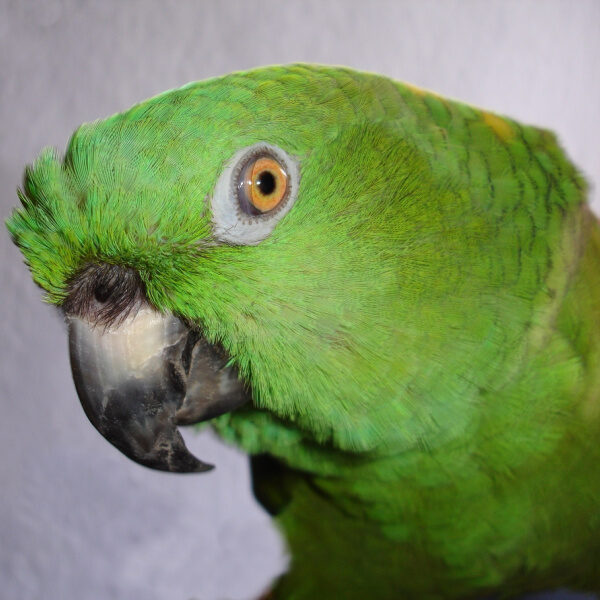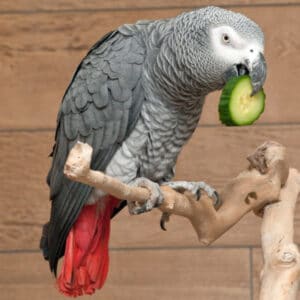Last Updated on by Catherine Tobsing
Lately, I have been villainized, accused of being self-righteous, and generally disdained by all the people who feel clipping their bird’s wings is the right thing to do.
So I proudly wear the Scarlet (Macaw) letter “F” (for Flighted) on my chest.
But I think we have done, thanks to Denise, a fine job of stating the benefits of wing clipping. And while the fight between the Hardfeathers and the Macaws rages on I’d like to bring some clarity to the situation.
Our corporate mission is “to be an advocate for the birds”. We want to make sure your bird is healthy whether its wings are clipped or not. I’d like to move from the debate for a moment and talk about caged bird foot care for birds that have clipped wings.
If a bird’s wings are clipped, it’s grounded. It basically does not fly. That means your bird is on its feet literally 24/7. This begs the question, “When was the last time you closely examined your bird’s feet?”
The case could be made that this is another transparent attempt to argue against wing clipping but while I was mulling over the importance of bird foot care, especially with birds who have clipped wings, I received this comment in a recent blog post Bird Parasites, Cage Litter & the Great Wing Clipping Debate which speaks for itself
Sandra
Dear Mitch, I could have lost my 50-year-old gorgeous double yellow-headed male Amazon due to a groomer’s error. She had known him for quite a while and knew his wings had NEVER been clipped. After she clipped his nails (I rarely have this done anymore with new nail pedicure perches/along with rope perches); she unconsciously clipped his wings as she was conversing with customers.
I came to find out that she clips all her customer’s bird’s wings. She is a high-end bird store owner and health adviser. Julius began to fall off his perch. The groomer told me to lower the perches and pad the bottom of the cage – that it was probably getting close to “his time” and that he was having mini-strokes.
She said that perhaps the trip to have his nails clipped had been too much for him. Sort of a long drive. She also suggested I take him to a vet to have him put down! After a few more days of horrendous sobbing, I took him to the vet to have him put down.
I had to have a driver. I had him in his travel cage on the console saying my goodbye. At a stop, Julius grabbed onto the wire side. I saw the bottom of his foot. It was raw and ripped up!!! (I would never have been able to see them otherwise.)
The vet and I figured out that he had lost his ability to balance after his wings were clipped and it took all his strength to hang onto a perch and he injured the bottom of his feet. It just got worse and worse.
How painful that must have been! The vet gave me medicines that helped his feet and pain. She also said that his health was excellent. But, I had called her before the trip and she said that it sounded like mini-strokes and that she’d humanely euthanize him when I got there. Imagine if I had not seen his foot. She wouldn’t have either as she avoided being bitten (A serious biter).
I kept a low perch as he hated being on the padded cage bottom…that was for the falls mostly. And as his wings grew back (thank goodness they did as they were clipped way too short!) his falls were less and less.
After his gorgeous wings returned to full size, he never fell again. I am so glad you have addressed bird foot health. Share this if you want to. I also have a clingy goffin, Ozzie, that will return to me flying outside, but we have hawks around. If I don’t give him enough attention, it shows up on his plucked belly. He was rehomed 5 times because he bit everyone and refused to come out of his cage.
Well, he’s very well trained now (9 tricks that he loves to do–he’s even on YouTube playing a child’s piano and drum). Now he only bites everyone BUT me! Someone damaged him along the way.
Julius is a damaged re-home too. After months, I used to be able to snuggle with him like a kitten, clip his nails, and take him anywhere. And, he also bit everyone, but me–flying attacks were not out-of-order for him.
Since the adoption of Ozzie, he bites me now if he steps up on my hand; deeply. He’s extremely jealous. I must always use a stick to move him. I’ve tried relocating them to separate rooms. Julius has to see him or he gets very upset.
Even at the groomer’s, we had to keep them within sight of each other. The two birds love/hate each other. On occasion, they’ve landed on each other’s cages. No injuries. Threatening moves, but I somehow feel that they would not go out of their way to hurt each other. Taking no chances. But one day when I was gone, Ozzie found out how to open his cage and flew over to Julius’s cage.
He figured out how to open Julius’s cage. There they were both sitting next to each other on top of Julius’s cage, like two peas in a pod. What am I doing wrong? Both are so madly in love with me. I keep explaining to them there is no way I’m going to lay an egg.
Thank you for that Sandra,
Feet check goes on the weekly care to-do list. Point made ’nuff said.
So I thought we’d have a little fun exploring things you might not know about your bird’s feet. There are several categories of bird feet including webbed and unwebbed. The five most common of bird’s feet configurations are classified as anisodactyl, zygodactyl, tridactyl, synactyl & didactyl

For this discussion we will focus on zygodactyl – two toes in front (2, 3) and two in back (1, 4) – the outermost front toe (4) is reversed on the feet of hookbills.
Many birds that perch like woodpeckers, owls, cockatoos, ospreys, and most parrots, have zygodactyl feet.
Interestingly woodpeckers can rotate the outer digit (4) to the side creating an ectrodactyly arrangement. Owls, ospreys, and turacos can move the outer toe (4) back and forth.
In this picture of the Macaw, I would be very concerned about the size of this piece of wood or perch with a too-small diameter. The toes should not wrap all the way around it.
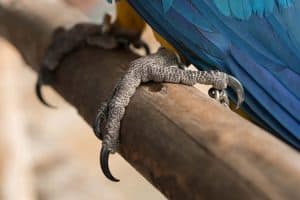
One problem to look for when your bird stands on a perch that is too small is the front toes 2 & 3 could accidentally injure the rear toes 1 & 4. For more about parrot foot maintenance read this.
The fun part about exploring is you never know where it’s going to take you. I found this really cool graphic of a pigeon’s skeleton.
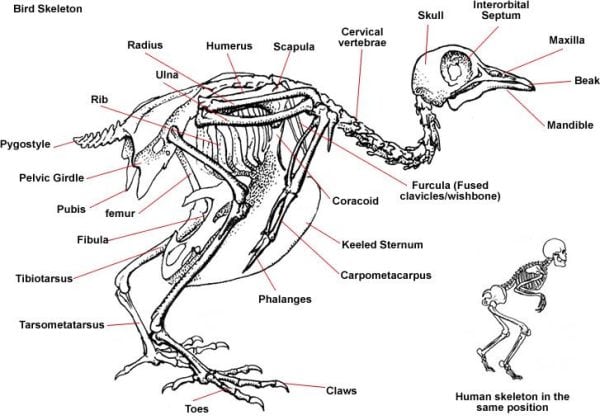
I’d like to point out the two bones (right and left) of the Tarsometatarsus, it’s what a calf is to us. What’s interesting is it’s only found in the lower leg of birds and certain non-avian dinosaurs.
Evolution formed the Tarsometatarsus by fusing several bones in other types of animals (we humans have two in our calf area, the Tibia and Fibula).
Although you see no ankle, the bird’s knees (Patella) are much higher up in the leg usually hidden by feathers.
Written by Mitch Rezman
Approved by Catherine Tobsing
Author Profile
Latest entries
 The Traveling BirdJune 26, 2025Can You Name 5 Parrot Species That Are Living Wild in the USA?
The Traveling BirdJune 26, 2025Can You Name 5 Parrot Species That Are Living Wild in the USA? Bird BehaviorJune 26, 2025How is it Parrots Are Problem Solvers Social Animals and Even Use Tools?
Bird BehaviorJune 26, 2025How is it Parrots Are Problem Solvers Social Animals and Even Use Tools? Bird & Parrot AnatomyJune 25, 2025How a Tiny Chemical Modification Makes Parrots Nature’s Living Paintings
Bird & Parrot AnatomyJune 25, 2025How a Tiny Chemical Modification Makes Parrots Nature’s Living Paintings PigeonsJune 20, 2025How Do Parrots Thrive in Cities Outside Their Native Habitats?
PigeonsJune 20, 2025How Do Parrots Thrive in Cities Outside Their Native Habitats?
